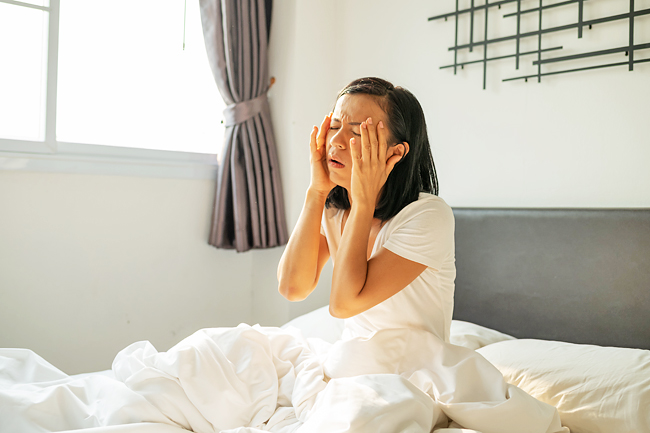Judith Graham
THE WASHINGTON POST – Nothing prepared Linda C Johnson of Indianapolis, United States for the fatigue that descended on her after a diagnosis of stage four lung cancer in early 2020.
Initially, Johnson, now 77, thought she was depressed. She could barely summon the energy to get dressed in the morning. Some days, she couldn’t get out of bed.
But as she began to get her affairs in order, Johnson realised something else was going on. However long she slept the night before, she woke up exhausted.
“People would tell me, ‘You know, you’re getting old.’ And that wasn’t helpful at all.
Because then you feel there’s nothing you can do mentally or physically to deal with this,” she told me.
Fatigue is a common companion of many illnesses that beset older adults, typically those 65 and older: heart disease, cancer, rheumatoid arthritis, lung disease, kidney disease, and neurological conditions such as multiple sclerosis, among others.



It’s one of the most common symptoms associated with chronic illness, affecting 40 to 74 per cent of older people living with those conditions, according to a 2021 review by researchers at the University of Massachusetts.
This is more than exhaustion after an extremely busy day or a night of poor sleep. It’s a persistent, whole-body feeling of having no energy, even with minimal or no exertion. “I feel like I have a drained battery pretty much all of the time,” wrote a user named Renee in a Facebook group for people with polycythemia vera, a rare blood cancer. “It’s sort of like being a wrung-out dish rag.”
Fatigue doesn’t represent “a day when you’re tired; it’s a couple of weeks or a couple of months when you’re tired”, said a research scientist at the Regenstrief Institute in Indianapolis Kurt Kroenke, which specialises in medical research, and a professor at Indiana University’s School of Medicine.
When he and colleagues queried nearly 3,500 patients 60 and older at a large primary care clinic in Indianapolis about bothersome symptoms, 55 per cent listed fatigue – second only to musculoskeletal pain (65 per cent) and more than back pain (45 per cent) and shortness of breath (41 per cent).
A VICIOUS CYCLE
Separately, a 2010 study in the Journal of the American Geriatrics Society estimated that 31 per cent of people 51 and older reported being fatigued in the previous week.The effect can be profound.
Fatigue is the leading reason for restricted activity in people 70 and older, according to a 2001 study by researchers at Yale University. Other studies have linked fatigue with impaired mobility, limitations in people’s abilities to perform daily activities, the onset or worsening of disability and earlier death.
Often, older adults with fatigue stop being active and become deconditioned, which leads to muscle loss and weakness, which heightens fatigue.
“It becomes a vicious cycle that contributes to things like depression, which can make you more fatigued,” said a Professor of Medicine and Chief Medical Officer at the University of Colorado Hospital. To prevent that, Johnson came up with a plan after learning her lung cancer had returned. Every morning, she set small goals for herself. One day, she’d get up and wash her face. The next, she’d take a shower. Another day, she’d go to the grocery store. After each activity, she’d rest.
In the three years since her cancer came back, Johnson’s fatigue has been constant. But “I’m functioning better,” she told me, because she has learned how to pace herself and find things that motivate her, such as teaching a virtual class to students training to be teachers and getting exercise under the supervision of a personal trainer.
WHEN SHOULD OLDER ADULTS BE CONCERNED ABOUT FATIGUE?
“If someone has been doing okay but is now feeling fatigued all the time, it’s important to get an evaluation,” said a physician at Scripps Mercy Hospital in San Diego and Board President of the American Academy of Hospice and Palliative Medicine Holly Yang.
“Fatigue is an alarm signal that something is wrong with the body, but it’s rarely one thing,” said Section Chief of the Centre for Geriatric Medicine at the Cleveland Clinic Ardeshir Hashmi. “Usually, several things need to be addressed.”
Among the items physicians should check: Are your thyroid levels normal? Are you having trouble with sleep? If you have underlying medical conditions, are they well controlled? Do you have an underlying infection? Are you chronically dehydrated? Do you have anaemia (a deficiency of red blood cells or haemoglobin), an electrolyte imbalance or low levels of testosterone?
Are you eating enough protein? Have you been feeling more anxious or depressed recently? And might medications you’re taking be contributing to fatigue?
“The medications and doses may be the same, but your body’s ability to metabolise those medications and clear them from your system may have changed,” said Hashmi, noting that such changes in the body’s metabolic activity are common as people become older.
Many potential contributors to fatigue can be addressed. But much of the time, the cause of fatigue cannot be explained by an underlying medical condition.
That happened to a retired nurse who lives just outside Portland, Oregon, Teresa Goodell, 64. During a December visit to Arizona, she suddenly found herself exhausted and short of breath while on a hike, even though she was in good physical condition. At an urgent care facility, she was diagnosed with an asthma exacerbation and given steroids, but they didn’t help.
Soon, Goodell was spending hours each day in bed, overcome by profound tiredness and weakness. Even small activities wore her out. But none of the medical tests she received in Arizona and subsequently in Portland – a chest X-ray and CT scan, bloodwork, a cardiac stress test – showed abnormalities.
“There was no objective evidence of illness, and that makes it hard for anybody to believe you’re sick,” she told me.
Goodell started visiting long COVID websites and chatrooms for people with myalgic encephalomyelitis/chronic fatigue syndrome. Today, she is convinced she has post-viral syndrome from an infection.
One of the most common symptoms of long COVID is fatigue that interferes with daily life, according to the Centers for Disease Control and Prevention.
Several strategies can deal with persistent fatigue. In cancer patients, “the best evidence favours physical activity such as tai chi, yoga, walking or low-impact exercises”, said an Associate Professor of Palliative Medicine at the University of Kansas Health System Christian Sinclair.
The goal is to “gradually stretch patients’ stamina”, he said.
With long COVID, however, doing too much too soon can backfire by causing post-exertional malaise. Pacing one’s activities is often recommended: doing only what’s most important when one’s energy level is highest and resting afterward.
“You learn how to set realistic goals,” said Senior Education Adviser at the Centre to Advance Palliative Care Andrew Esch.
Cognitive behavioural therapy can help older adults with fatigue learn how to adjust expectations and address intrusive thoughts such as, “I should be able to do more.” At the University of Texas MD Anderson Cancer Centre, management plans for older patients with fatigue typically include strategies to address physical activity, sleep health, nutrition, emotional health, and support from family and friends.
“So much of fatigue management is about forming new habits,” said a palliative care and integrative medicine physician at MD Anderson Ishwaria Subbiah.
“It’s important to recognise that this doesn’t happen right away: It takes time.”



